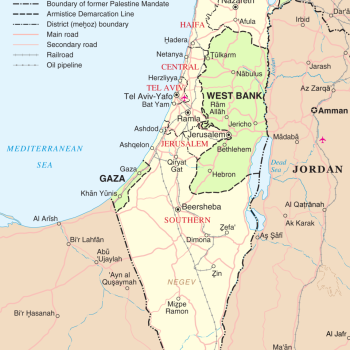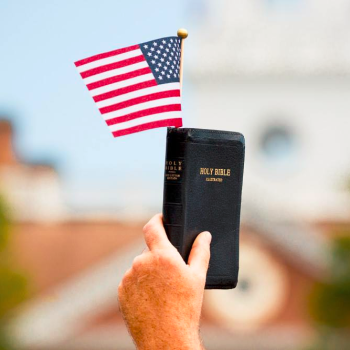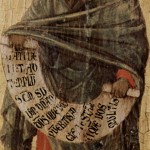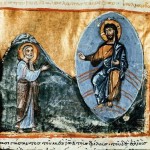
Hello from Columbus, Ohio, where my home denomination, the Christian Church (Disciples of Christ) are holding its General Assembly. We gather once every two years to express our unity, hash out differences of opinion, and see to the business of operating a mainline denomination. I’m having an especially good time this year since I’m spending most of my time at the booth for the Iliff School of Theology, the school where I’m employed, and I’m getting the chance to chat with alumni and friends as folks make their way through the exhibit hall.
Here are the texts for the ninth Sunday after Pentecost, along with some thoughts on them and how to preach them.
What It’s About: This is the iconic and powerful story of David and Bathsheba. It’s a story of adultery, murder, intrigue, and the greed that accompanies power, and it’s a stunning vignette in the life of a man–David–who is described as being after God’s own heart.
What It’s Really About: What is this story really about? I think there are two main ways to answer that.
The first way to read the story is as a tale about sin (or, Sin): about how brokenness and fallenness winds its way into our souls and our lives, and entwines us in webs of deceit and treachery. This is a profoundly individualistic way to read the story. In this telling, David and Bathsheba fall victim to lust, and they find in each other the opportunity to act out their basest desires. This concession to sin necessarily leads to larger sins, and before you know it, David is ordering the death of Uriah.
The other way to read this story is as a tale about power. This is a more communal reading, as it takes account of the various relationships involved and the ways those holding the power in those relationships can bend the narrative to their needs and desires. Ask yourself this: Could Bathsheba have consented here? I don’t think she could have; she was targeted by a preying king who summoned her to his palace. Even if she had wanted to, she couldn’t have said no. And look at the relationship between David and Uriah; Uriah is painted here as someone so imbued with honor that he would take no privilege that others couldn’t take (in contrast to David). But I think something like duty might be more operative here. Duty is closely aligned with honor, of course, but we have to remember that Uriah acts the way he does out of fealty to his king, David. David holds the power, so Uriah acts in accordance, and dies in accordance.
These two ways of reading the story are both, in some ways, about sin. But one focuses on sin as a private affair, a weakness of the heart or even the loins. The second way still understands sin to be undergirding the whole story, but here sin is more insidious. It’s not a personal moral failure. It’s exploitation and murder brought about by the accumulation of power to one person. And it turns out that this kind of accumulation of power is exactly what God warned the people about when they demanded a king.
What It’s Not About: This isn’t a story about romance. Why do we read it as a story about romance? Even the famous song Hallelujah, which is among my favorites, romanticizes the very real coercion at the heart of this relationship. (Again, she couldn’t have said no).
Maybe You Should Think About: What do you make of David and Bathsheba’s lasting marriage if you read the story in these two different ways? The lectionary will follow this story as it unfolds, but it’s worth asking now: does the marriage that arises from this event change our perceptions of it? Does it help us forgive or rationalize it? And is that ok?
What It’s About: This is a kind of benediction–and not a particularly Pauline one, in my quick-and-dirty estimation. I don’t have my bibles and commentaries here with me on the road, but this seems to me to be a hollow echo of Pauline language, and not very convincing.
What It’s Really About: If this is a benediction, it is poorly placed. Careful observers will notice that the letter goes on another three chapters past these lines, and this might point to a seam in the letter where more than one ancient work has been made into a single book. This was common (see: 2 Corinthians), and it ought not give us too much concern. But here, it definitely makes it sound like the letter is concluding, only for it to pick back up again in dramatic, “hey look at me I’m Paul!” fashion in chapter 4.
What It’s Not About: It’s not about much, honestly. I always feel bad writing that, since my evangelical past rises up to scream at me that “all scripture is God-breathed,” but sometimes I think we have to accept that certain passages have less to say to us than others. Maybe this one speaks to you, though, where it doesn’t speak to me.
Maybe You Should Think About: For a New Testament scholar, I don’t know Greek super-well. (I’ve got to work on that). I can pick my way through, but I’m no savant or anything. But one thing that always troubles me is the way the word hagios is translated. The word means something like “holy” or “sacred,” but usually in the New Testament where it refers to people it is translated “saint.” But it could just as easily (I think; someone with better Greek than me could correct me) be translated “holy one.” The distinction, I think, is largely one of chronology and theology. If Ephesians is early and Pauline, maybe the line should read “with all the holy ones” or “with all the ones who are holy.” But if the letter is later and not authentic to Paul, and enough time has passed that the first generation of Christians has died out, then maybe the NRSV’s “with all the saints” is preferable. I don’t know which is best, but I always pause on the word “saint” in the New Testament, because it’s one of those places where later theology can really influence the meaning we get from the text.
John 6:1-21 and 2 Kings 4:42-44
What It’s About: I put these two stories together because they are telling the same story, in different ways. Christians have a propensity to conceitedness, as if we invented every good and miraculous deed of God. But many of the story in the New Testament have precedent and root in the Hebrew Bible, and the miraculous feeding stories–of which this passage from John is one–are good examples. In 2 Kings, Elisha orders a mass of people to be fed with food that shouldn’t be enough, but like the stories in John and the synoptic gospels, there is plenty and some left over.
What It’s Really About: It seems clear, doesn’t it? This is a story about God’s plenty. God is in the business of setting plentiful tables. It’s interesting, though, that in both the case of Elisha and Jesus, some agent of God was needed to point out the plenty, and to facilitate its reception by the people. This is a hedge against those who might say, “see, God provides if you’re willing to go work for it.” In both stories it took a faithful person to make it happen. God’s people are the waitstaff of God. It’s our job to set the tables.
What It’s Not About: I don’t think this is about miracle. This is an understated miracle! There is no dramatic moment where one loaf of bread pops into five. There is simply the dawning realization that what they thought was scarcity was actually abundance. There is nothing of the whiz-bang stage magician here; it’s not magic. Something much deeper is on display here: that plenty reigns where we expect scarcity, if only God’s people would faithfully set the table.
Maybe You Should Think About: What does the author of John gain by re-telling this story from 2 Kings? Of course, the author (and the authors of the synoptic gospels) might be telling stories that occurred in the real world. But they probably would have known this story from 2 Kings, so we have to assume that it operates in the background. What does putting Jesus into Elisha’s shoes do for the story? What does it do for the depiction of Jesus? What does it gain for the reader?
















